The Last-of-the-series 1964-'66 Chevrolet C-10s Are Among the Best of the Breed
Buyer's Guide
04/08/2022
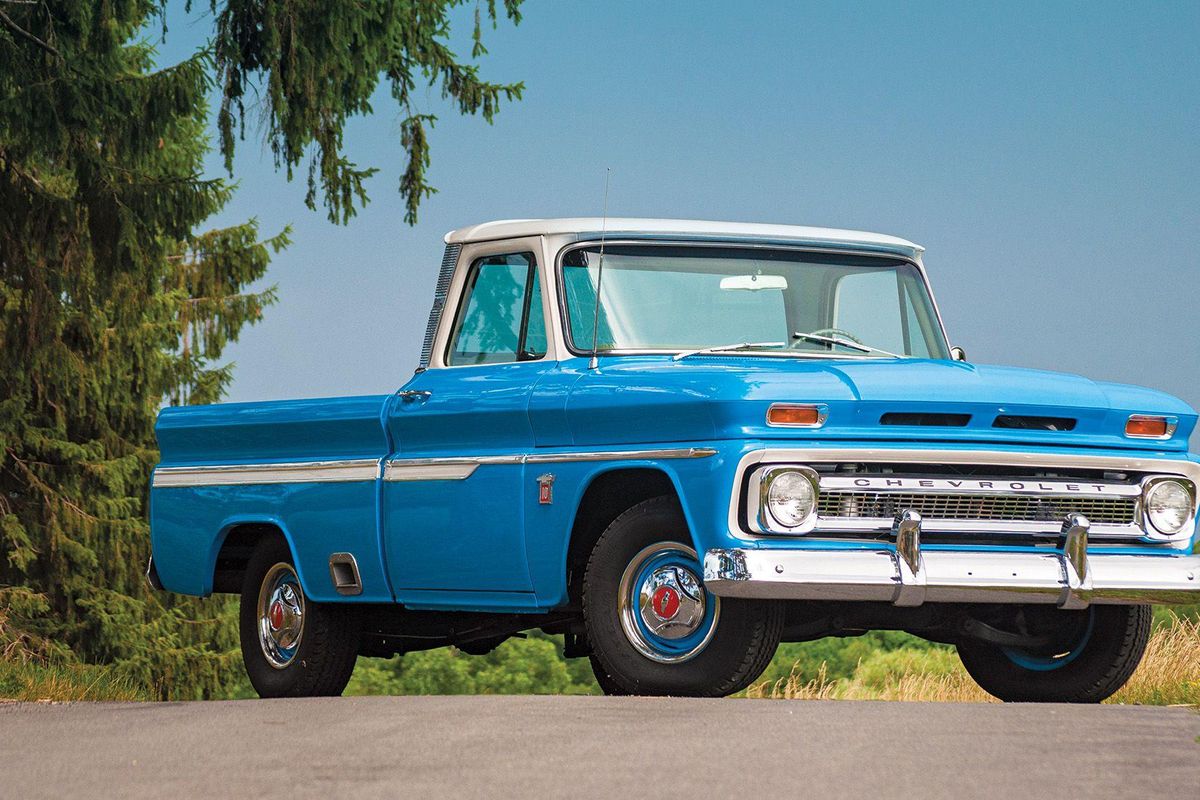

General Motors lit the afterburners on its light trucks for 1960, with radical new Jet-Age styling and a totally revamped chassis under two-wheel drives. There was no mistaking these trucks from their 1955-’59 Task Force predecessors, as they were lower, wider, and designed with a never-before-seen emphasis on driver convenience and comfort.
Front and center were two massive jet-inspired air intakes that dominated the full-width hood—a styling cue lifted from ’59 Chevrolet cars. The truck’s flat-top or "flying wing" roof was also borrowed from Chervolet’s full-size cars, as was its rearward-angled A-pillar and wraparound windshield.
Beneath the skin, the cab roof was reinforced by an inner panel ribbed for increased rigidity, and there was insulation sandwiched between the layers. The cabs boasted a 26 percent increase in windshield area over their predecessors for a commanding view of the road, plus there was nearly 6 inches more hip room, more shoulder room, head room, leg room, and new door sealing.
The Fleetside bed made its debut on Task Force trucks but really took hold with buyers during the 1960-’66 model run and nicely complemented the new cab’s angles. The workaday stepside was still available, though it carried over with only minor changes from the second-series 1955 pickups.
The 1960s Chevrolet trucks featured jet-inspired air intakes, a "flying wing" roof, and a cab that prioritized driver comfort.
These trucks rode and handled more car-like, thanks to changes to the front and rear suspension. While Task Force trucks rode on solid axles with leaf springs at both ends, for 1960 Chevrolet went to torsion bars up front on ½-, ¾- and 1-ton two-wheel drive trucks. Two-wheel-drive ½-tons of this vintage took it a step further with rear coil springs, while heavier editions stuck with more rigid leaf springs.
Chevrolet’s all-in approach to modernizing its light trucks may have sparked a little future shock in buyers but, from behind the wheel, the new haulers must’ve felt like luxury cars compared to every other truck before or compared to the competition. As the decade wore on though, GM made the trucks a little more conventional with evolutionary changes. The big intake snouts on the hood were among the first things to go, replaced in ’62 by a pair of small cut outs on the hood’s forward edge.
Also in ’62, the quad headlamps were replaced with single headlamps. In 1963, GM switched from a torsion bar front suspension to a coil spring front end. In 1963, Chevrolet also introduced two new engines: the 140-hp, 230-cu.in. straight-six and the 165-hp, 292-cu.in. six-cylinder. The 175-hp 283 engine would remain the only V-8 option and all engines were equipped with alternators rather than generators.
For 1964, Chevrolet light trucks received a reworked cab that incorporated more modern design cues. The A-pillars and windshield were swept back slightly, the glass wraparound was eliminated, and the vent windows were shaped like triangles. The severe roof overhangs, which gave the older cabs a sort of pagoda style, were eliminated as well.
The 1965 model year saw the debut of the 327-cu.in. V-8 and in 1966, a new 250-cu.in. straight-six was introduced. GM’s 1960-’66 trucks are quite collectible today, with popular pricing guides placing them in the $20,000 range on the low end, up to $100,000 on the high end.
If a restoration of one of these trucks is in your future, you’ll find that used, reproduction, and NOS parts are widely available for 1960-’66 light-duty GM trucks. The early hoods with the big air intakes aren’t being reproduced, but used panels are out there, though getting scarcer. Ditto for pre-’64 doors.
For this guide we’re going to focus on the 1964-’66 trucks as they have the most in common, but any of the trucks in this series make excellent collectibles. This month’s feature truck is a 1964 Chevrolet C-10 that belongs to Chevrolet truck enthusiast Rich Rosetti of Latham, New York. It’s nicely equipped with a Custom Cab, air conditioning, a 283 V-8 paired with an automatic transmission, power steering, and more.
Rust is the biggest enemy of these trucks. Fenders and doors are relatively straightforward to shore up with aftermarket panels or replacements but addressing rust in the cab can be more time consuming and expensive. Rocker panels and rear outer cab corners are commonly rusted and easy to spot. Look closely under the cab at the inner rockers and the channel-shaped floor supports beneath the cab. Often the supports will be rusted away or feel spongy because they’ve become plugged with debris and then deteriorated from the inside out. It’s common, too, for the inner rocker to be rotten where the floor support attaches.
The bottom of the cab column, where the door mounts, is also a frequently rusted area and can be a chore to fix. The floorpans are rust prone too, particularly around the outer edges of the toe boards where they meet the sides of the cab. Cowls can rust too, which can be difficult to spot without disassembly, but if there’s a lot of water leaking inside the cab, this is something to consider. For 1964-’66 trucks, sheetmetal to repair cabs and front ends is widely available. Some of the aftermarket pieces fit perfectly, some will require a bit of massaging.
On stepside trucks, the bedsides can rot along the floor, particularly if a truck has had a piece of plywood placed over a damaged or missing factory plank floor. (Often the wood can become saturated and rot the metal.) The bolt-on fenders rust anywhere dirt can accumulate and reside—look especially close at the area where the fender is bolted to the step. The stepside boxes of these trucks are almost exact carryovers from the Task Force trucks with minor changes to the bed floor attachments. Good quality reproduction sides and fenders are available.
On Fleetside trucks, look for rust damage around the wheelhouses, as well as in front of and behind the wheelhouse on the lower portions of the bedsides. Patch panels as well as complete reproduction bedsides—6-foot and 8-foot—are available. The floors in the stepside and Fleetside boxes are all wood, and kits are available.

On deck for 1964 were the 140-hp, 230-cu.in. straight-six and the 165-hp, 292-cu.in. six-cylinder. The 283 engine would remain the only V-8 option, and all engines were equipped with alternators as standard equipment, beginning in ’63, rather than generators.
The 1965 model year saw the debut of the 327-cu.in. V-8 and in 1966, a new 250-cu.in. straight-six was introduced. The 230 and 250 sixes are rugged, reliable engines. The 292 was designed for severe duty and heavier applications, so it’s understressed in a half-ton truck. Parts are still widely available for Chevy sixes, including hop-up bits to add a little more power.
The 283 and 327 Chevrolet V-8s are among the easiest engines in the world to rebuild and maintain. Even if your goal is numbers-matching concours correctness, a small-block in a Chevrolet pickup probably won’t break your budget. One detail worth noting: Chevrolet light-truck engines weren’t painted Chevrolet Orange in those days. The 230s and 250s were painted blue, 292s were green, 283s were gray, and the 327 was green.
Transmission choices included the base three-speed, or the optional heavy-duty Warner T89 three-speed (with a non-synchro first gear), a four-speed, or the Powerglide automatic. (The three-speed Turbo Hydra-Matic was available in 1966 on ¾- and 1-ton trucks.) Overdrive was offered with the three-speeds, though not with the 327 or on trucks equipped with a governor. The base three-speed was the SM318 in trucks, though later 1966 trucks could have the all-synchro SM326. Both are good transmissions under normal use, and easy to rebuild. The biggest problem is probably with the linkage, which can bind and jam if worn out or improperly adjusted.
The Warner T89 is unusual to find in one of these trucks as it cost nearly as much as the four-speed. It’s also more difficult to find parts for.
The four-speed offered was the SM420. It has a compound-low first gear, synchros in second through fourth, and it’s basically bombproof.
Powerglides sometimes gets a bad rap but, if you’ve ever lived with one, you know the drill: they’re clunky, often leaky, but virtually indestructible. For the sake of originality, they’re cheap and easy to rebuild. If you’re doing a lot of driving, a four-speed automatic makes a big difference.
The ’64-’66 half-tons rode on a chassis that was revised for the ’63 model year. The front torsion bars introduced in 1960 were out and coil springs with control arms were in. The rear still bounced on coils, but they were an updated two-stage design for better ride and load capacity. The frame rails were made of heavier-gauge channels than earlier frames, with seven crossmembers tying them together.
Power steering was available, but these trucks used a hydraulic cylinder that boosted the drag link, rather than a power steering box. Brakes were 11-inch hydraulic drums at all four corners, operated by a single-reservoir master cylinder with optional power assist.
The rear axles were all GM truck 12-bolts, but the ’64 used 17-spline axles while ’65-’66 used 30-spline axles, and all of these trucks had six-lug hubs. A Chevrolet two-wheel-drive truck chassis is a model of simplicity and function. Parts are widely available and they’re easy to work on. Frame rust isn’t common, but it’s possible particularly in the rear around the suspension attachment points or in the crossmembers.

Buyers could choose between the standard cab or the extra-cost Custom Cab, but both were pretty spartan compared to today’s luxury-truck cabins.
Standard bought you the basics: vinyl seat upholstery, a driver’s side sunshade, an outside door lock only on the driver’s door, a rubber floormat, and a dome light. A full-depth foam seat with vinyl upholstery was optional.
The Custom Cab included the full-foam seat as standard issue, in nylon fabric trimmed with vinyl. It also boasted a driver’s armrest, exterior door locks on both sides, chrome-trimmed control knobs, a cigarette lighter, two sunshades, and a steering wheel with a horn ring similar to some Chevrolet passenger cars.
Many interior parts for these trucks are reproduced, and used pieces are out there. Seat upholstery kits are available in many colors, as well as in cloth and vinyl. The custom steering wheel isn’t reproduced and there are two designs: 1961-’65, and a different wheel for 1966. It’s interesting to note that very often ’64-’66 trucks turn up with interior hard surfaces that have been repainted in body color, like later Chevrolet pickups. The factory only painted them in metallic beige or fawn and the ’66 trucks had a darker brown dash with a flat finish.
The collectible pickup market is pretty hot right now and Chevrolets are among the hottest. For years, the 1960-’66 trucks trailed the late 1950s and late 1960s/early ’70s trucks in value but they’ve really gained ground. The earlier trucks of this series have become more sought after than in the past, because of their unique styling, but the 1964-’66 trucks still represent a strong value at today’s prices, and they’ll likely keep appreciating for years to come.
| Low | Average | High | |
| 1964 Chevrolet C-10 Pickup Truck | $20,000 | $37,000 | $98,000 |
| 1965 Chevrolet C-10 Pickup Truck | $19,000 | $35,000 | $87,000 |
| 1966 Chevrolet C-10 Pickup Truck | $19,000 | $42,000 | $64,000 |
| Average Price | |
| Cab floor, left or right side | $80 |
| Coil spring, front and rear set | $135 |
| Door shell | $650 |
| Fleetside bed side, short | $600 |
| Fleetside bed wood kit, oak | $490 |
| Fender | $190 |
| Front bumper, chrome | $218 |
| Gas tank | $150 |
| Grille | $315 |
| Heater core | $70 |
General Motors introduced radical Jet-Age styling and a completely revamped chassis for its 1960 light trucks. The trucks featured jet-inspired air intakes, a "flying wing" roof, and a rearward-angled A-pillar with a wraparound windshield, distinguishing them from the 1955-’59 Task Force predecessors.
The trucks from this period were designed with a focus on driver convenience and comfort. They had a 26% larger windshield, more room inside, and better door sealing. As for performance, the trucks transitioned from solid axles with leaf springs to torsion bars up front for some models and introduced new engines such as the 140-hp, 230-cu.in. straight-six and the 165-hp, 292-cu.in. six-cylinder.
On deck for 1964 were the 140-hp, 230-cu.in. straight-six and the 165-hp, 292-cu.in. six-cylinder. The 283 engine remained the primary V-8 option. In 1965, Chevrolet debuted the 327-cu.in. V-8, and in 1966, a new 250-cu.in. straight-six was introduced. Alternators replaced generators from 1963 onwards. Transmission options ranged from a three-speed, a four-speed, Powerglide automatic, and the three-speed Turbo Hydra-Matic for some models.
Rust is often found in fenders, doors, rocker panels, rear outer cab corners, cab columns, floorpans, and cowls. Specific for Fleetside trucks, rust might be seen around the wheelhouses and the lower sections of the bedsides. Stepside trucks can show rust along the bed floor and on the bolt-on fenders.
As of the last update, for a 1964 model, prices range from $20,000 on the low end to $98,000 on the high end. For 1965, the range is from $19,000 to $87,000, and for 1966, it's between $19,000 and $64,000.
Yes, many parts for the 1960-’66 GM light trucks, from body panels to engine components, are widely available. Reproduction, used, and NOS parts can be sourced for these models. Some examples of parts prices include a cab floor panel for $80, a door shell for $650, and a chrome front bumper for $218.
Wagons are arguably the most practical form of transportation. By extending the relatively low roofline of its sedan counterpart, wagons offer plenty of precious cargo space while still retaining a lower center of gravity for zippy handling and spirited driving whenever the urge may hit. Despite all the fun that can be had in a wagon, massive high-riding SUVs and Crossovers have taken over the modern-day automotive market.
The SUV trend is unstoppable and new wagon models are becoming scarcer as years pass. Back in 1975, sedans and wagons dominated nearly 80-percent of the U.S. vehicle market. More recently, new SUV and truck sales have climbed to around 80-percent since 2011, taking the place of smaller sedans and their longroof model varieties.
In the classic car market, wagons are rapidly gaining popularity. Like the old saying goes, “They don’t make them like they used to.” Classic wagons exude a style that isn’t seen in today’s automobiles and car enthusiasts are gobbling them up like candy. Here are 15 examples of what is available in the classic wagon market today.
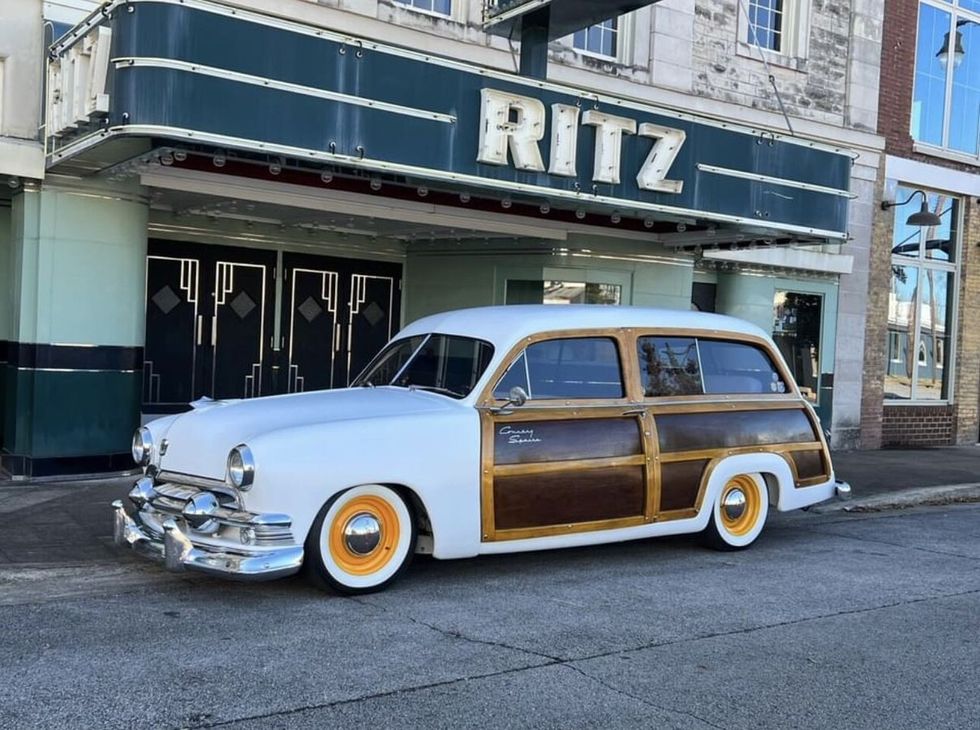
Everybody loves a classic woodie wagon! This two-door 1951 Ford Country Squire wagon still sports its original wood paneling, not that fake plasticky stuff seen on the more modern “wood” wagons. The seller states it is a fresh build that has only been driven 500 miles. A 350-cid Chevy Vortec Engine is hidden under the hood. Tasteful modifications include a Fatman Fabrications front end, an 8.8-inch rear end, power steering, four-wheel power disc brakes, and an all-new interior.
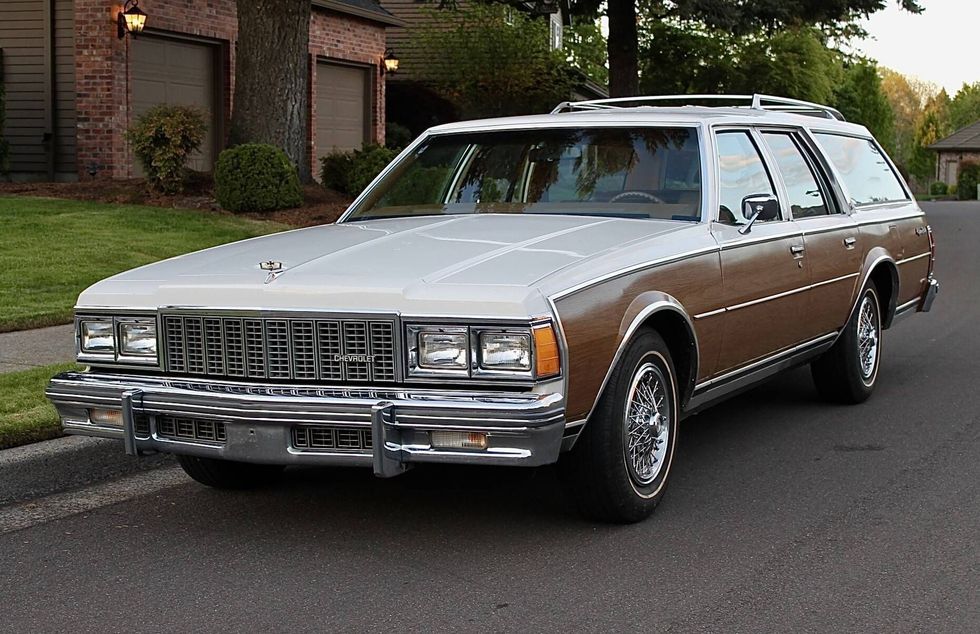
As stated in the auction listing, here’s a family hauler that would draw envious glances from Clark Griswold, this 1979 Chevrolet Caprice Classic Station Wagon is believed to be in original condition apart from maintenance and service requirements, according to the selling dealer, who acquired the woodgrain-trimmed wagon through an estate sale. There’s a 350 V8 under the hood and the seller notes service within the past few thousand miles has included new brakes, a new water pump and radiator, valve cover gasket, muffler, and more. Click here to see the full auction details.

“Experience the epitome of vintage charm and modern performance with the 1964 Mercury Colony Park, a California wagon that's been meticulously restored and upgraded to perfection. Underneath its classic blue exterior adorned with wood paneling lies a beastly 390-cid V8 engine, now equipped with a Holley Sniper EFI system for improved fuel efficiency and smoother power delivery. Paired with an automatic transmission, this wagon delivers a driving experience that's as effortless as it is exhilarating.”

This beautiful Brookwood underwent a professional frame-off custom restoration. It’s a restomod of sorts, still sporting its classic looks while implanting some modern creature comforts and technologies. It’s powered by a 480 horsepower LS3 engine paired with a six-speed manual transmission, for starters. Cruise to the classified to see more photos, plus the full list of custom goodies included in this immaculate 1959 Chevrolet Brookwood Nomad.
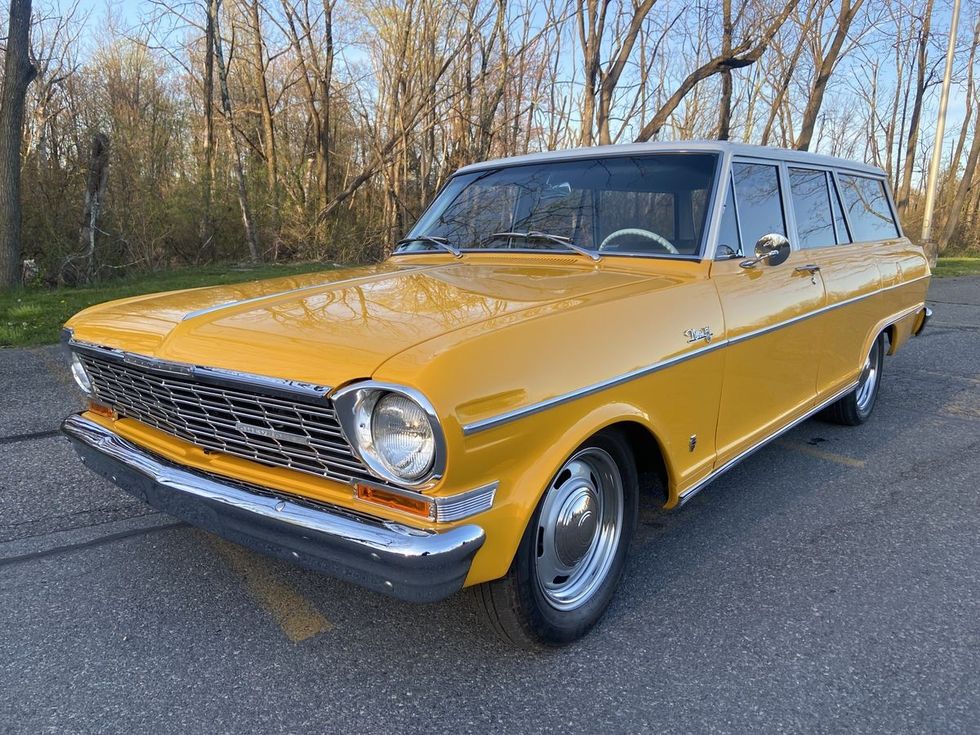
You’ll be hard-pressed to find a classic wagon exactly like this one-of-a-kind 1964 Chevrolet Chevy II Nova. Described as a mild restomod, this station wagon has just 1,000 miles accumulated since its frame-off restoration. The seller states that everything has been done on this car and it “rides, drives, and handles way better than you would expect; straight down the road with no shimmies, shakes, or vibrations.” The craftmanship on this V8-powered Chevy wagon is described as “simply spectacular.”
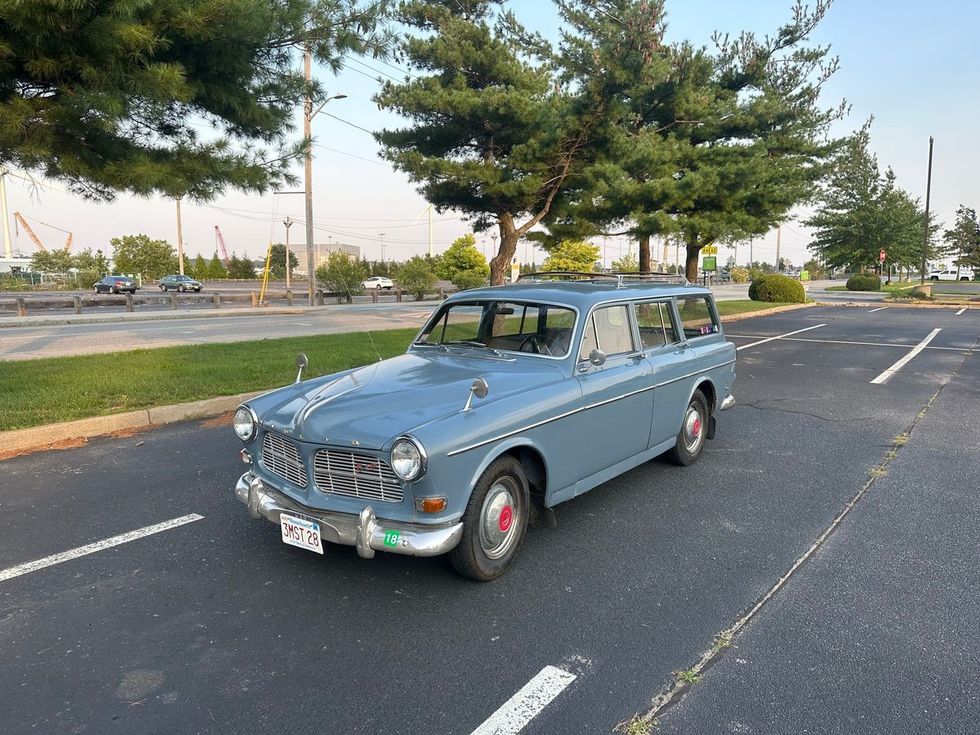
Volvo wagons are getting hard to come by, especially the 1960s-era cars. The seller states that this two-owner, mostly original 1963 Volvo 122S B22 was used as a daily commuter until a few years ago, has been regularly serviced, and is in good running condition with a recent fuel system overhaul. The original exterior does have some blemishes and surface rust, but the seller assures that “With a fresh paint job, she would really turn heads!”
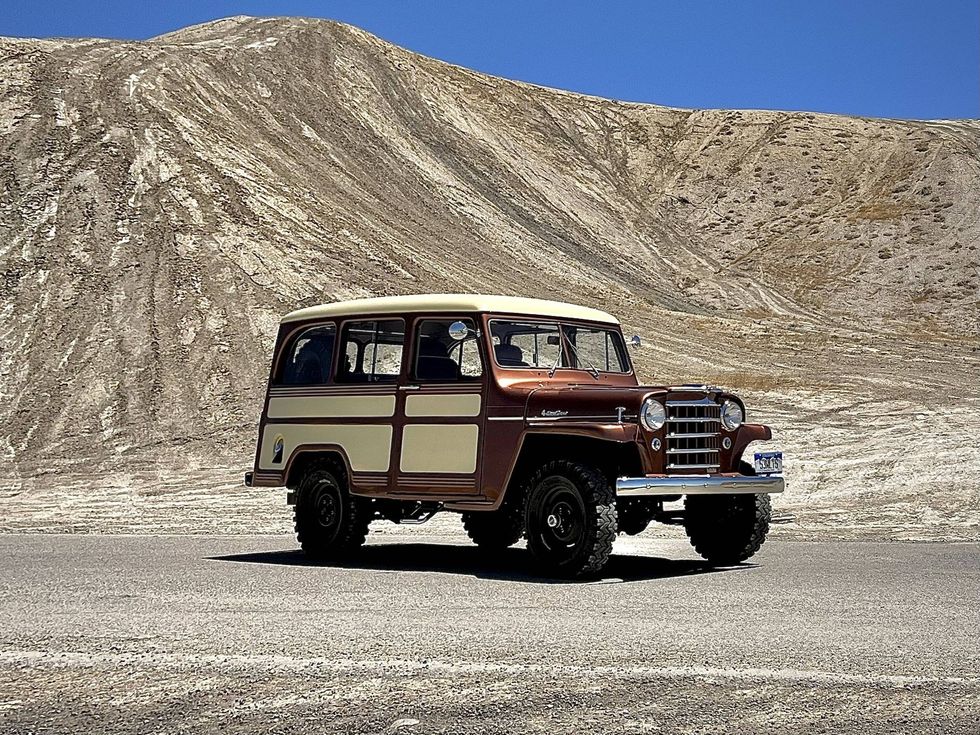
“There are refurbishments and restorations, and then there’s the kind of treatment this 1953 Willys Station Wagon has received. The work is described as a minutely detailed body-off restoration that has left the wagon in better-than-factory condition. Among the many non-production upgrades said to have been performed on this Willys are heated leather seats, a lamb’s wool headliner, a Pioneer audio system with Bluetooth capability, map lighting, and USB charging ports. The Willys is reported to have a replacement F-head engine of the same year and displacement, now rebuilt, and the wagon is described by the seller as free of rust.”

A muscle car in wagon form is what dreams are made of, especially when talking about the second-generation Chevrolet Chevelle SS. This example, a Placer Gold 1971 Chevrolet Chevelle SS Wagon, gets its power from a rebuilt 402 cubic-inch V8 producing 350 horsepower paired with a T-10 4-speed manual transmission geared with a 10-bolt rear end, plus other great features.
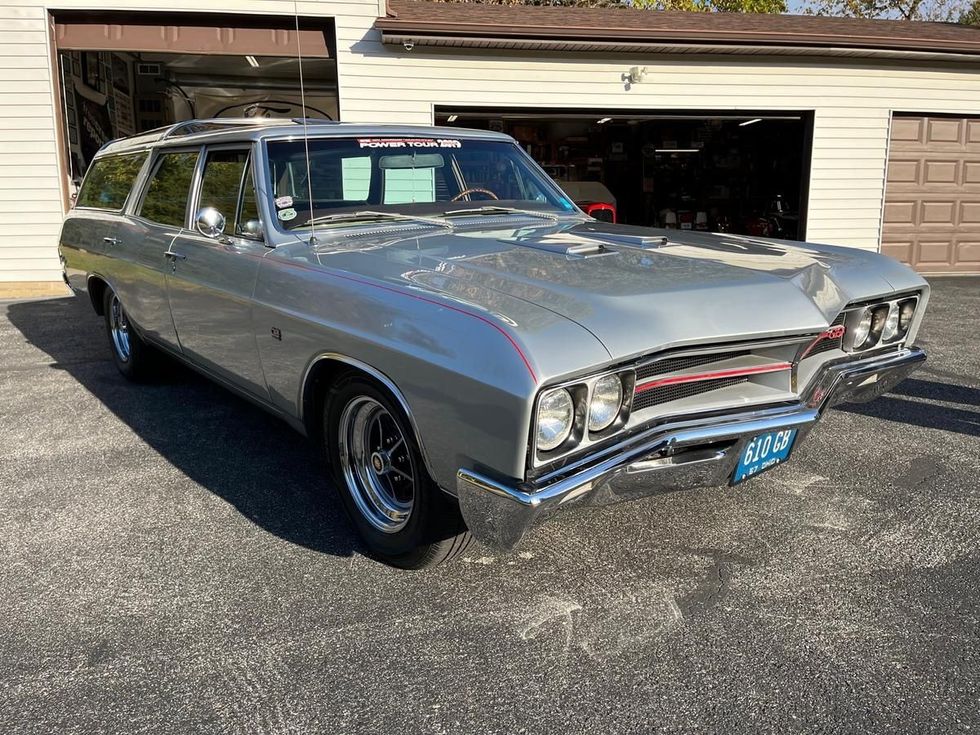
The sky roof (or panoramic roof) on this 1967 Buick Sport Wagon GS adds to this classic car’s luxurious feel. The seller states it is powered by a 350 cubic-inch small-block topped with four-barrel carbs and a Star Wars-style air cleaner. The wagon is described as rust free and ready to drive.

According to the seller of this custom 1956 Ford Parklane Two-Door Wagon, it is so clean that you can “eat off the door jams and spare tire well.” The mild custom sports a 312 cubic-inch V8 paired with an automatic transmission, plus loads of other goodies, including a custom interior. Take a close look at the photos supplied in the Hemmings Marketplace classified listing.
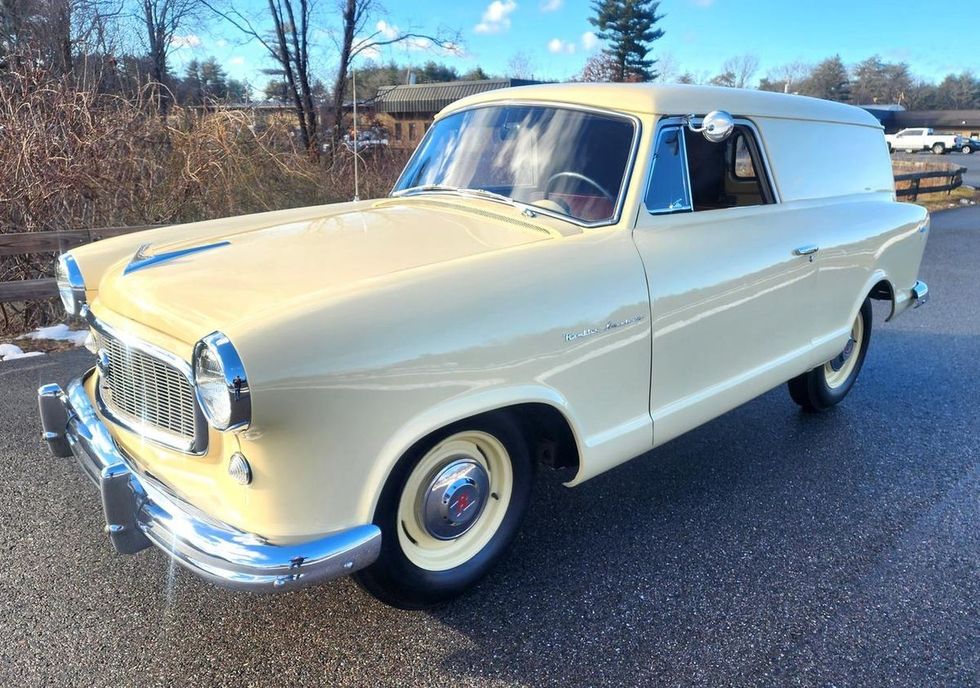
This extremely rare wagon is just one of only three examples produced, and the seller confirms that they do have the production records as proof. Previously owned and restored by the founder of the AMC club of America, the 1959 Rambler American Deliveryman Panel underwent what is described as an exceptional nut and bolt rotisserie restoration just a few years ago. It’s powered by an inline-six engine backed by a three-speed manual transmission, and the engine bay, among other details, is described as stunning.

The classic Chevrolet Bel Air embodies the American Dream of the late-50s, and its V8 engine signifies the era of American muscle. This elegant wagon is offered with an automatic transmission for easy cruising. The seller also states that the 1957 Chevrolet Bel Air is equipped with air conditioning, its classic AM radio, power brakes, and power steering.

If you’re searching for a wagon that will stop passersby in their tracks, look no further than this flame-adorned 1950 Oldsmobile. Under the hood you’ll find a powerful 5.7L Vortec 350 cubic-inch V8 paired with a smooth-shifting four-speed automatic transmission. The seller states, “this Oldsmobile Wagon is not just about looks and performance, it’s also equipped with a range of features designed to enhance your driving experience.” Get the full details here.

This unrestored 1959 Plymouth wagon shows 78,800 original miles on the odometer. The 318 polyhead Mopar engine is topped with a Holly two-barrel carburetor and exhales through a dual exhaust system. Don’t let the main photo of this beautiful machine on a trailer fool you: The seller states that the car is in survivor condition and it drives without issues. Check it out.

This two-door, six-passenger, V8-powered 1958 Edsel Roundup wagon is described by the seller as a no expense spared custom. The customizations were completed by its owner, Frank Montelone, alongside his long-time friend, the legendary George Barris of Barris Kustoms, which makes this custom wagon an incredibly rare find.
There are more wild wagons where these came from. As of this writing, there are around 50 classic wagon listings on Hemmings Marketplace. Take a look!
Smack dab in the heartland of America, Enid, Oklahoma is an exceptionally friendly small town with a triad of great car shows that occur in three consecutive weekends. The fun starts with the Boy Scouts Show, which is always the last Saturday in March, then the Corvette Expo on the first weekend of April. For 2024, there is a newcomer to Enid’s car show scene: the Shepherds Show & Shine, which lands on the second Saturday in April.

Harold Clay, owner of Clay’s Collision Center and Harold’s Hot Rod Shop in Enid, called me at home in California and asked if I could offer our mutual friend Tom’s daughter some tips on how to put on a charity car show for her church (St. Paul’s Lutheran Church and School) for its first attempt. I’m in Enid several times a year, so I knew the Boy Scouts car show is traditionally held on the last Saturday in March followed by the Corvette Expo always on the first Saturday in April. I Googled to see if April 13th was okay to hold Shepherds 1st Annual Custom & Classic Car Show & Shine and it looked like the coast was clear.

Famous last words. On January 28, 2024, I posted Shepherds Show & Shine flyer on Clay’s Collision Center’s Facebook page to help promote the new show. Immediately the proverbial poop hit the fan. Folks had misread the flyer and erroneously thought Clay’s Collision Center was the promoter of Shepherds show, so Clay’s phone started ringing off the hook with people asking for show information. Who knew Easter would fall on March 30, 2024? I couldn’t find it announced anywhere online that the Boy Scouts Show had moved their date from late March to April 13, 2024, one week after the 32nd Annual Corvette Expo came to Enid.

The wheels were motion and it appeared that neither party would back out, so consequently both car shows were set to take place on the same day. The early morning of April 13 started out a little stressful and then as the morning progressed plenty of cars, pickups and motorcycles started rolling into Shepherds 1st Annual Custom & Classic Car Show & Shine. A great success, the Shepherds show was an absolute nostalgic time warp. St. Paul’s church was built in 1926 and the beautiful old houses in the neighborhood circa 1927 set the mood. It was a good scene, the adjacent fenced schoolyard to the car show grounds was packed with children playing and dogs on leashes were everywhere… classic rock ’n roll music filled the air.

At 1:30pm Harold and I jumped into his chop-top ’60 Chrysler New Yorker and headed over to the Boy Scouts show that was hosted by the Enid Antique Auto Club at the Chisholm Trail Expo Center. Just like the Shepherds Show & Shine, admission for spectators at the Boy Scouts Show was free to all. Interestingly, the cars shown indoors at the Boy Scouts Show were mostly of a different style than the cars that rolled into Shepherds Show & Shine held outdoors, so the number of show cars was high at both locations. And Harold and I noticed a lot of the spectators we spotted at Shepherds were also present at the Boy Scouts Show, so apparently all that is well, ends well.
Photo: John Gilbert
Kathy Burge’s 302-powered 1976 Ford Bronco has been in the family since purchased brand new.





